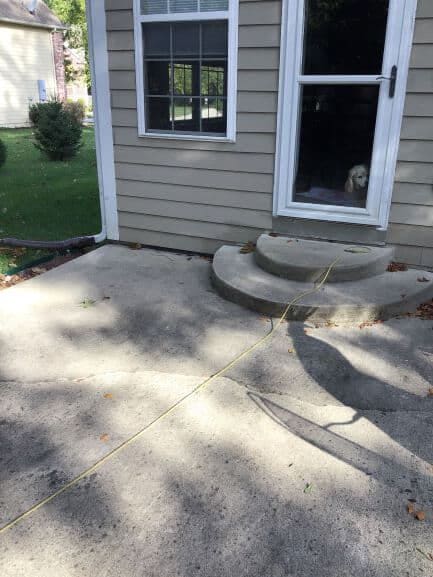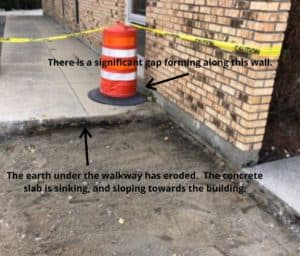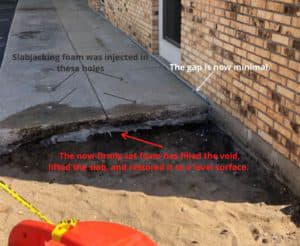How does Concrete Lifting Work?

Originally posted 11/20/19, revised 8/6/21
Concrete slabs are an essential component when you’re building a home. Not necessarily for the home itself- although many homes do have a slab foundation- but for everything around your home. You have one or more of the following: sidewalks, patios, driveways, porches, steps… There may also be a slab beneath your air conditioner or as the base of a retaining/privacy wall.
When these slabs crack, shift, or sink, they create problems. Uneven concrete can be a trip hazard, it can collect water, and it can redirect water in an unwanted direction. You want to fix these slabs before they cause damage to your home or hurt a family member, of course! But you’re not too eager to break the bank or destroy your yard in the process.
Acculevel has been lifting concrete since Andy Beery started the company in 1996. We began by using a process called mudjacking, and did this with good results for many years. But in 2014, we adopted a newer method of concrete lifting called slabjacking. This has proven to be a superior process, and we have since used it with great success for thousands of customers.
Raising sunken concrete through slab jacking extends the life of your concrete and prevents the need for replacement. In this article, we’ll explain both concrete lifting methods, highlight the pros and cons of each, and provide additional resources that will help you decide which repair process is best for you.
 Both of these photos were taken by Acculevel employees, before and after slabjacking lifted the porch next to the house.
Both of these photos were taken by Acculevel employees, before and after slabjacking lifted the porch next to the house.
Why Do Concrete Slabs Sink?
The concrete around your home sinks for a number of reasons. The most common causes are: changing soil conditions, improperly compressed soils, erosions from downspouts or drains, and uneven weight distribution. If left untreated, you may need to replace the sunken concrete, which can be expensive, messy, and leave you unable to use the concrete during the repair.
Concrete lifting returns a concrete slab back to its original position by filling the ground beneath it. There are two methods of concrete lifting available: mudjacking and slabjacking. Both are cheaper and faster than tearing out and replacing the concrete. They are also less invasive and damaging to your landscape and property.
| Mudjacking (Competitors) | Slabjacking (Acculevel) | |
| Material | Concrete slurry: a mix of limestone, concrete, sand, and water | Polyurethane foam |
| Drill size | 1 to 1.5 inches | ⅜ of an inch |
| Curing time | Hours or days, depending on quantity of material | Less than an hour |
| Durability | 5-10 years | In most cases, permanent |
| Potential issues | Like concrete, it can decay, break apart, erode or sink | Can sink if soil erosion is significant underneath the injected foam |
| Warranty offered | 1-5 years | 5 years |
Mudjacking uses water in the mix, and this makes it susceptible to the effects of weather. It can freeze, which means it cannot be used if the air temperature is at or below freezing. Slabjacking can be done unless the actual ground is frozen, regardless of air temperature.
The foam used in slabjacking begins as a liquid, so it can be injected through a much smaller hose than mudjacking slurry. Once the slabjacking liquid begins to foam and react, it sets up within minutes. You can see this in the video below; while working on a job to raise a sidewalk, we had a rare opportunity to film the process from below the slab:

 These are photos of the job site where that video was made, taken by Acculevel crew members.
These are photos of the job site where that video was made, taken by Acculevel crew members.
Slabjacking can be a permanent solution, if the cause of the sinking is corrected. For example, let’s say your sidewalk is sinking because a downspout drains next to it. If you extend the downspout so the water drains into your yard, the sidewalk should remain in place (once slabjacking is completed). Mudjacking uses a diluted version of concrete, which can degrade or erode over time. This is why the warranties differ between the two methods.
Have a sinking slab, but not sure if slabjacking will repair it? We provide multiple examples (with photos) that show what is and isn’t a good candidate.
What’s the Next Step?
Do you want someone to visit your home, assess the areas of concern, and give you an estimate? If so, you’ll want to find an experienced specialty company, and make an appointment. Before you sign a contract for any service, please always verify that the company is reputable, insured, and accredited by the Better Business Bureau.
Not sure what questions to ask, or what information you should acquire about the company you hire? Our guide, Questions You Should Ask a Contractor, includes a free downloadable form.
If you live in Indiana or the surrounding areas, contact Acculevel. Established in 1996, we specialize in foundation repairs, concrete leveling, and waterproofing. If you have noticed sinking or cracking on any of your concrete slabs, you can request a free estimate. An experienced project manager will evaluate the sections of concern and recommend the best course of action for you, to keep your home strong and healthy for years to come.
